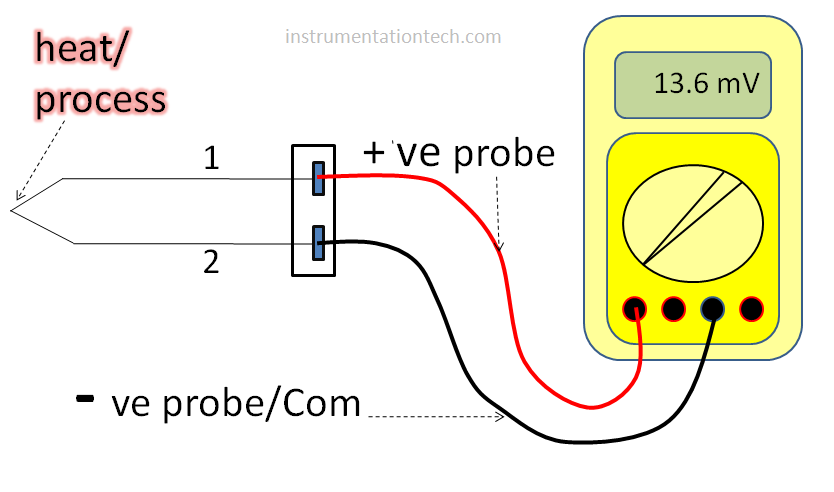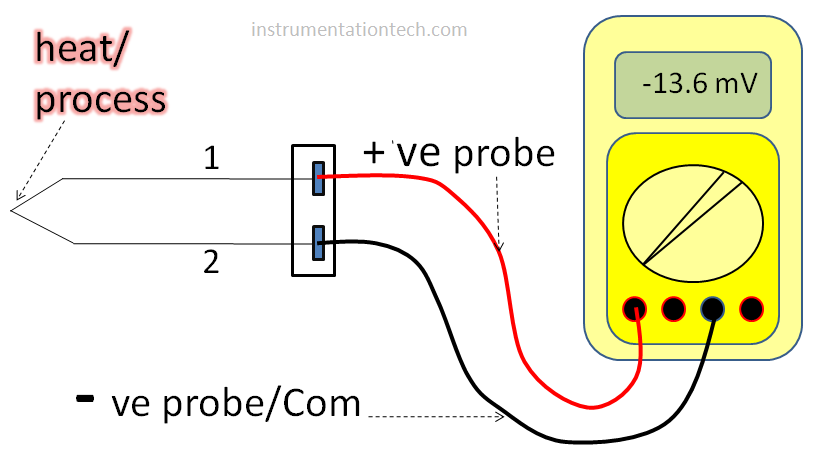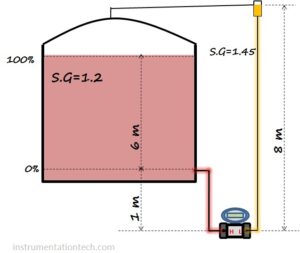Thermocouple, a popular sensor widely used in industries for temperature measurement . Basically they are metal and metal alloy combination joined at one end .They are active sensors which produces a voltage signal which is proportional to the temperature gradient between it’s junctions (Seebeck effect).Thermocouple leads polarity is important one while we are dealing with their maintenance or calibration jobs ..In this article we will learn thermocouple lead polarity identification methods .Means how to identify the positive and negative leads of a thermocouples .Let us see some methods .
Suppose you are in a maintenance work to. And you have to connect a thermocouple extension wires to the terminals of thermocouple which is mounted in a vessel or tank or any other process location .The process fluid has some temperature well above room temperature .You have forgotten to note the terminal connections and you want to identify the terminals .As wrong connections will lead to error in measurement and cannot display the proper temperature ,you should identify the polarity of the thermocouple leads . one of the following tricks will help you.
Thermocouple leads polarity identification
1.Know the colour codes
For each types of thermocople there is a specific colour codes for each leads . By knowing the colour codes we can identify the thermocouple leads polarity .These colour codes may vary in country to country .So one need to know the specific colour code used in his concerned area for a particular type of thermocouple .
2.Trial and error method
Make connections by connecting wires to the any terminals and check the reading in HMI or in temperature indicator .If HMI or indicator displays the error , this means our connections is wrong and the polarity need to be reversed .swap the connections and by checking again you can see the the error message has gone and indicating temperature..Simple and a common procedure .But the problem is you may be forced to make the connections twice if the first attempt has given a wrong result .Then it is always better if we knew the polarity before making connections .Connecting the wires on the base of assumptions may be lead to the wastage of time and effort .So it is better to know the lead in polarity somehow.The below described method will help you in such situations .
2.checking with multimeter
Polarity of thermocople leads can be identified by checking the polarity of the generated millivolt signal.
Check the millivolts signal
Place the multimeter probes in it’s correct slots for mv measurement .Check the common and voltage probes are at the correct slots
check the millivolts.If it is positive the multimeter to thermocouple connections are correct .And the one connected to positive probe of the thermocouple is positive and common probe of the thermocouple is negative .
If the reading is negative the lead çonnected to multimeter positive probe is negative and the other one is positive.For avoiding confusion it is better to swap the connections and you can find the reading as positive .Then find the positive probe which is the lead çonnected to the positive probe of the multimeter .
In lab you can do the same procedure .But you need to apply some temperature to the thermocouple tip otherwise it gives 0 mV.This is because if the both junctions are at same temperature, thermocouple output will be zero as there is no temperature gradient .So inorder to check the polarity of the leads you have to apply a small extra temperature at thermocouple tip .This can be done by rubbing the thermocouple tip with hand .And do the procedure as above .
In the below figure the lead of thermocople numbered as 1 is the positive lead because the multimeter reads a positive millivolt .So the +ve probe is çonnected to +ve of thermocouple and – ve probe is çonnected to – ve of the thermocople .
Lead 1 is positive

In the below figure the lead of thermocople numbered as 2 is the positive lead because the multimeter reads a negative millivolt .So the +ve probe is çonnected to -ve of thermocouple and – ve probe is çonnected to + ve of the thermocople .You can find the millivolt reading changes to a + ve value if we reverse the probe connections to thermocouple leads .
Lead 2 is positive

Magnetic character
Some thermocouple shows magnetic property.For example the negative lead of K type thermocouple is magnetic and its positive lead is non magnetic.So one can make the identification of thermocouple lead polarity by bringing a magnet near to the leads of such thermocouple .Usually negative lead shows magnetic character and positive leads are non magnetic.

